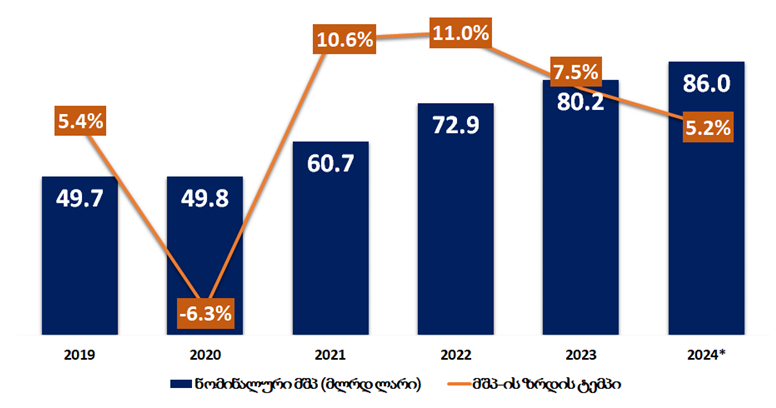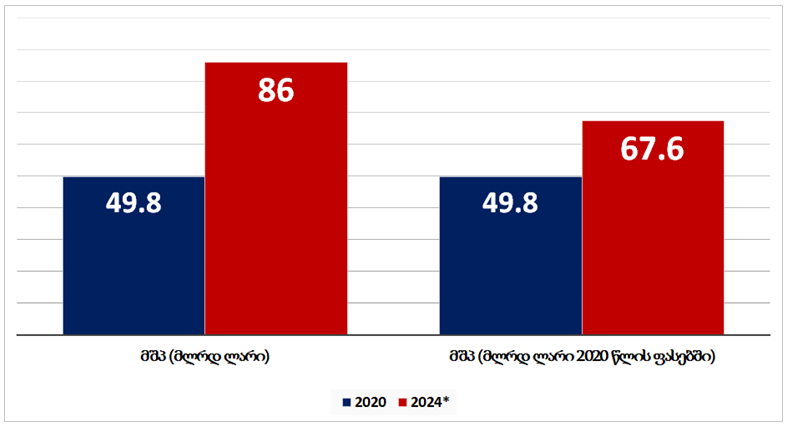Irakli Kobakhidze: “The economy expanded by GEL 40 billion in the past four years.”
Verdict: FactCheck concludes that Irakli Kobakhidze’s statement is HALF TRUE.
The economy amounted to GEL 49.8 billion in 2020 whilst the projected value of the economy in 2024 constituted GEL 86 billion. This figure could increase slightly due to the higher-than-projected growth rate of the gross domestic product (the growth has reached 9.7% in the past seven months whereas the initially projected value was 5.2%).
The nominal economy will be at least GEL 36 billion higher by the end of 2024 than in 2020. However, two important issues arise: the base pandemic year and inflation as ignoring these factors can distort the reality.
The GDP decreased by 6.3% in 2020 due to COVID-19 regulations, resulting in factory shutdowns – marking the largest downturn since 1994. The double-digit growth observed in 2021 is largely attributed to the re-opening of the previously closed businesses. This trend was observed in most countries worldwide.
Consumer prices have increased by more than 27% since 2020. Notably, the economy grew from GEL 49.8 billion to GEL 67.6 billion when measured in 2020 fixed prices, indicating a GEL 18 billion increase, which is less than half of the figure cited by the Prime Minister.
Whilst the presented statistics are more or less accurate, two essential factors – the base pandemic year and inflation – were omitted from discussion. Thus, FactCheck concludes that Irakli Kobakhidze’s statement is HALF TRUE.
Analysis
When presenting the first 20 MP candidates for the 2024 parliamentary elections, Prime Minister Irakli Kobakhidze claimed (from 7:35): “We expanded the Georgian economy by GEL 40 billion in the past four years.”
Irakli Kobakhidze was referring to the 10th term of the Parliament of Georgia which began its work in December 2020. Thus, the ‘past four years’ refers to the period from 2021 to 2024.
The Georgian economy amounted to GEL 49.8 billion in 2020 and GEL 80.2 billion in 2023. The projected value for 2024 constitutes GEL 86 billion.
The time period cited by the Prime Minister is characterised by two important factors which should not be omitted: the base effect of COVID-19 regulations and a high inflation rate.
The economy decreased by 6.3% in 2020, marking the largest downturn since the 1990s. Notably, the structural problems of the economy did not lead to the aforementioned decline, but the shutdowns in the accommodation, catering and retail industries. Furthermore, transportation was also halted. Subsequently, the re-opening of the recently closed factories led to growth in 2021.
Georgia was no exception to the aforementioned trends. Whilst most European countries faced the largest downturns in 2020 since World War II and the US experienced its most significant decline since the Great Depression, the growth observed in 2021 marked historical highs of the previous decades.
The Georgian economy expanded by 10.6% in 2021 as compared to 2021 and by 3.6% as compared to 2019.
Graph 1: GDP and the GDP Growth Rate

Source: National Statistics Office of Georgia
Inflation is another factor which could alter the perception of the reality. Although the economy decreased by 6.3% in 2020, the nominal GDP saw a slight increase from GEL 49.7 billion to GEL 49.8 billion.
The real economy increased by 32% from 2021 to 2023, marking a notably high growth for a three-year period. However, the growth of the nominal economy was twice larger, amounting to 61% (from GEL 49.8 billion to GEL 80.2 billion). This difference can be primarily attributed to inflation as consumer prices rose by 27% during the same period.
Notably, GEL 86 billion in 2024 holds the same purchasing power as GEL 67.6 billion in 2020 (the January-August 2024 average inflation rate of 1.2% was used for calculations). Whilst higher-than-projected economic growth could result in a slight increase in the aforementioned figure, such adjustments would not significantly alter the overall picture.
Graph 2: GDP

Source: National Statistics Office of Georgia
The nominal economy is projected to increase by GEL 36.2 billion by the end of 2024 as compared to 2020. This figure could potentially rise to GEL 40 billion due to the higher-than-expected growth rate; however, the aforementioned rise is reduced to GEL 18 billion when considering inflation. Whilst the presented statistics are more or less accurate, two essential factors – the base pandemic year and inflation – were omitted from discussion. Thus, FactCheck concludes that Irakli Kobakhidze’s statement is HALF TRUE.








